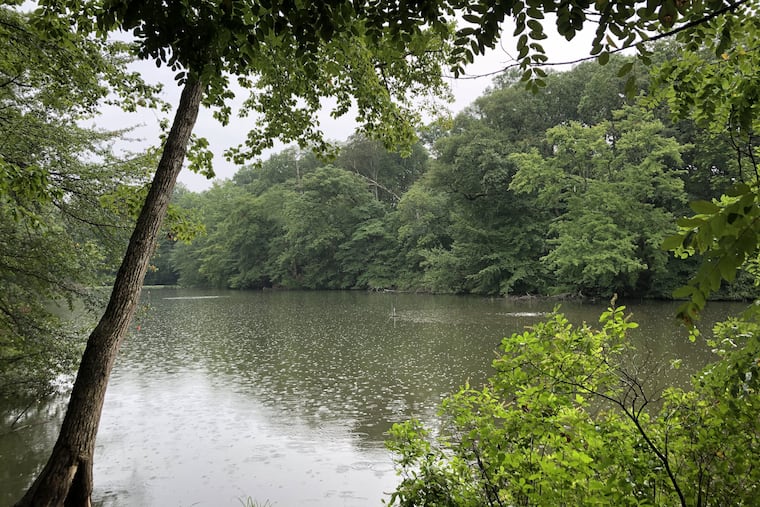How this picturesque Haddonfield pond became a toxic algae problem
In 1789, scions of Haddonfield’s founding family damned a part of the Cooper River and created what is to this day a scenic pond that has become a “poster child” for the state’s toxic algae problem.

In 1789, John Estaugh Hopkins dammed a small tributary of the Cooper River to power a grist mill, creating what is to this day a scenic, forested pond tucked behind a back road in Haddonfield.
Now, Hopkins Pond is an emblem of the state’s toxic algae bloom problem.
Scientists with the New Jersey Department of Environmental Protection tested the pond on July 29 and discovered high levels of microcystis, a cyanobacterium that creates harmful algal blooms. The cyanobacteria produce neurotoxins that are dangerous to people and pets.
The algal blooms were responsible for sweeping shutdowns of some of New Jersey’s best-known lakes last year, including Lake Hopatcong on the border of Morris and Sussex Counties, popular with swimmers because of its beach. The closures sent state officials scrambling for answers to the toxic blooms and led to the creation of a new warning system this year, complete with interactive map of hot spots.
As of Thursday, Hopkins Pond was the only location in the state in the red level, the second-highest warning, which means a body of water poses a “high risk of adverse health affects due to high toxin levels.” Though no one swims in Hopkins Pond, dogs sometimes slosh in it.
The 33-acre Hopkins Pond, and its small connector Driscoll Pond, is in the Pennypacker Park section of Camden County’s park system that surrounds the Cooper River. The pond is rimmed by woods and dirt trail, complete with wooden bridge.
The harmful algal blooms (HABs) were still present as of Thursday, and have been present off and on since at least 2013.
HABs, also referred to as blue-green algae, are an environmental problem in all 50 states and a yearly occurrence at some lakes and ponds. But they drew national interest last year when four dogs died in North Carolina after swimming in a pond loaded with them.
» READ MORE: N.J. creates warning system for harmful algal blooms after last year’s lake closings
Environmentalists say the problem is worsening as more development leads to more impervious surfaces that shunt runoff of fertilizers and other pollutants directly into waterways. Algae thrive on the nutrients, phosphorus and nitrogen. They say runoff is more voluminous with the intense storms resulting from climate change, and that state and municipal officials haven’t upgraded storm water management practices to tackle the problem.
Bruce Friedman, director of DEP’s water monitoring and standards, said Hopkins Pond’s location and layout make it a prime candidate to receive those nutrients.
“Hopkins Pond is a small water body … in a very suburbanized, urbanized area that receives a lot of storm-water runoff, which carries a lot of nutrients from the surrounding development,” Friedman said. “So it’s sort of like a poster child for what you would expect.”
Friedman doesn’t blame the blooms on climate change, but said scientists believe it plays a role.
“Last year we had algal blooms that continued throughout the winter. And in part, that’s because we didn’t have a real significant freeze,” he said.
Vic Poretti, also with water monitoring and standards, said in recent years he’s seen trouble spots in Salem County, some ponds in Mount Laurel, as well as a pond at Amico Island Park, on the Delaware River in Burlington County.
Maggie McCann Johns, director of Camden County’s Department of Parks, said the county has been trying for at least seven years to address the problem, and is working with Mike Haberland, an agent with Rutgers Cooperative Extension.
The county has erected signs to caution visitors. It has also installed an aeration system and a transducer that produces ultrasonic sounds that disrupt the algae. The combination seemed to be working, with no real issues in 2019. Then, the problem arose with a persistence this year, and the county installed an even more powerful transducer that she said appears to be helping.
“We have had issues in the past with Hopkins Pond,” McCann Johns said. “It’s sort of an outlier in terms of how much deeper it is than other lakes.”
McCann Johns said the pond is 14-feet deep and the water gets stratified, meaning there are layers of water with different temperatures. Cooper River Lake, less than two miles away, was dredged a few years ago to about five feet deep.
Cyanobacteria can thrive when bodies of water become stagnant and stratify. They can move up and down in water to find just the right amount of light they need for photosynthesis. As a result, they can block nontoxic algae. So mixing and aerating the water can help.
McCann Johns said the county plans to test for phosphates and nitrogen, two nutrients. She believes climate change is not helping.
She cited not only Tropical Storm Isaias but storms in July, as well as an additional two inches of rain parts of the county received in just a few hours in a Wednesday. It rained again Thursday. Hopkins already receives a lot of storm runoff.
“We’re designing for 100-year storm events,” McCann Johns said of related county projects. “But in reality, we’re getting 100-year storm events every year.”